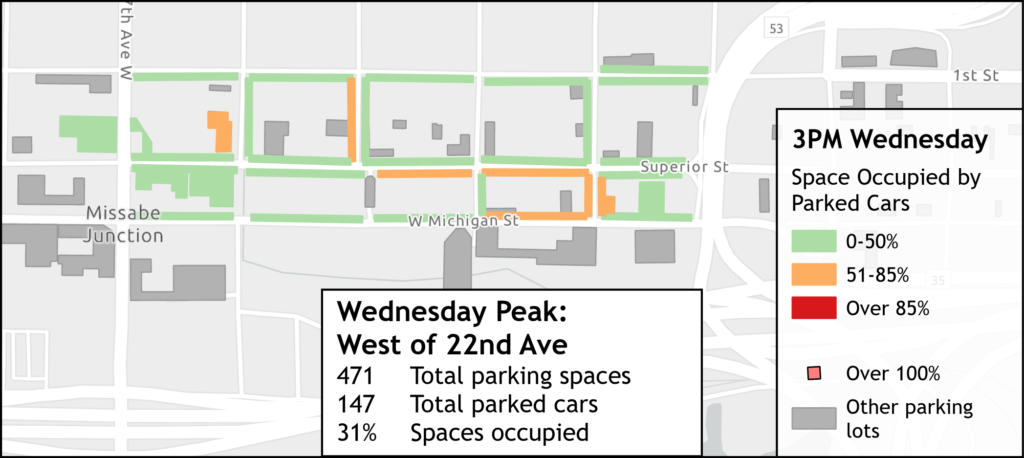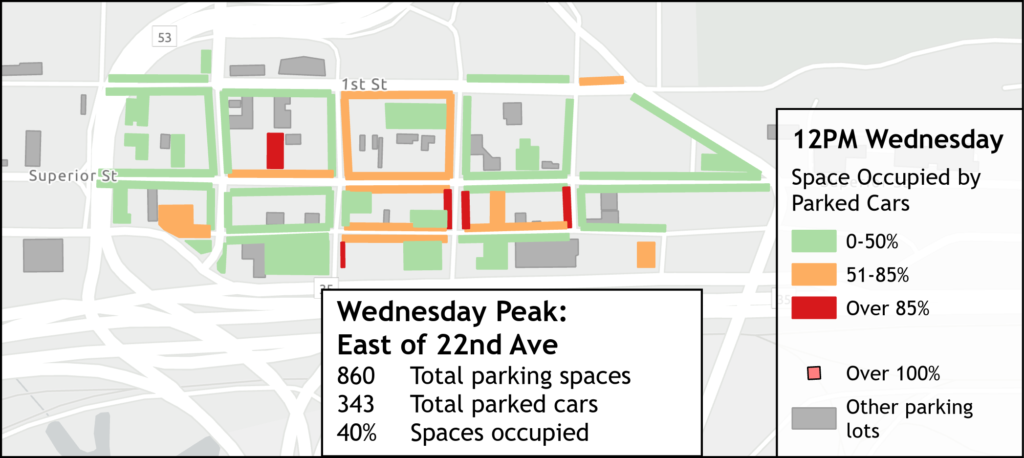This past February, Main Street Lincoln Park conducted the first of two parking studies in the Craft District with the help of the City of Duluth. After months of work, we’re finally ready to present the findings!
These parking studies are being conducted in preparation for the reconstruction of W Superior St. Since the activity in the district can vary depending on the season, we’re doing one study in the winter and one in the summer. With the growth of new businesses and housing in the Craft District, the demand for and concerns about parking have increased over the years. Many people have claimed that there are not enough parking spaces.
However, a study has never been conducted to examine this issue since this growth. Adding additional parking spaces can be very costly and take space away from other potential uses. Considering the lasting impact of this reconstruction, decision makers need to be intentional about who and what these public spaces are for. This can include parking, along with future mobility, sustainability, and economic vitality goals. These studies will help inform decision makers when considering the design of the road.
With the help of some amazing volunteers, the winter parking study was completed on Wednesday, February 22, and Saturday, February 25 (a fairly quiet and non-eventful week). Typically, parking or traffic counts are done on Wednesdays because they theoretically represent the average parking numbers in a week. However, we also chose to count on a Saturday, the district’s busiest day of the week, to get a snapshot of the peak numbers.
The study we are conducting is called a parking occupancy survey, which only counts the number of cars. It does not record data such as how long people stay, violation rates, or number of unique vehicles visiting the neighborhood. Cars parked on the street and in parking lots were counted every three hours from 6:00 am to midnight. This was done along W Superior St, First St, Michigan St and all the avenues from W Michigan St to Carlton St, which is the length of the reconstruction project. Volunteers came out during the district’s busiest times on both days at 12:00 pm, 3:00 pm, and 6:00 pm to receive a quick training, count cars, and report back with their numbers. The rest of the times were counted by Main Street Lincoln Park and the City of Duluth.
There are no publicly-owned parking lots in the neighborhood, but we included private lots that were either open to the public, customer-only, or resident-only. We didn’t count employee-only lots, except for the TBI Residential & Community Services lot (located at W Michigan St and 20th Ave) and the Kern & Kompany lot (located at 2110 W 1st St). We also missed some customer-only lots in our initial review, but they will be included in the next study.
Conditions
Wednesday was a cloudy, windy day and Saturday was a sunny, slightly breezy day. The midnight counts were not done on Wednesday night because we had decided it wasn’t worth counting that late on a weekday with snow in the forecast.
When this study was conducted, there was ongoing construction for the Highway 53 bridge, which affected 22nd Ave and parking spots that were underneath it. There was also construction at 2005 W Superior St (the old Seaway Hotel), which had closed off access to the alley from 20th Ave. There was also a section of 26th Ave between W Superior St and W Michigan St that was not plowed and therefore not counted.
Results & Discussion
Below are videos of the maps showing the levels of parking occupancy throughout the day. The data that was gathered west of 27th Ave are not shown because there was almost no activity in that area on both days (only 1-2 cars parked throughout the entire day).
The data was categorized into three levels: no spaces occupied to half full; half full to 85% full; and over 85% full. We chose 85% as one of the limits because an area is considered “full” when 85% of spots are occupied (called the 85% rule). This is when people will notice there are still a few spots available, but it’s harder to find, and when better parking management should be in place so that it doesn’t reach 100%. In our study, some blocks have over 100% occupancy, which happened when there were cars parked illegally or in unofficial spaces.
During the early morning and late night times, it is estimated that the darker colored areas show where residents were parking: around 18th Ave, the Enger Lofts lot, and the Lincoln Park Flats lot. Throughout the day, it appears that people are parking either right by the business they’re going to, such as from 18th Ave to 20th Ave, or about 1-2 blocks away. Outside of that, there are many available spaces that people weren’t utilizing. On Saturday, the blocks on 20th Ave were over-parked during certain times. On the southern block of 20th Ave, this happened because people disregarded the parking meter-marked spaces and instead parked in any available space. On the northern block, there were cars parked in the no parking zone (from the alley to 1st St).
Peak Maps
Below are maps showing the times of the day with the most number of parked cars (peak time) for each day.


For Wednesday, the peak time for the whole district was during lunch time at noon, with most cars parked near the food establishments. For Saturday, the peak time was early evening at 6:00 pm when people were most likely eating dinner or grabbing drinks and were parked near the food or drinking establishments. In both instances, only a little over one-third of all the available spaces in the district were occupied. Even when excluding the employee-only lots, there was only a 2% difference between the two measurements for both days.
Since there can be a difference in activity between the area west of 22nd Ave (more breweries and cideries) and east of 22nd Ave (more restaurants and retail), they were examined separately to see if the peak times differed from each other on both days (shown below).


On Saturday, there was no difference between the peak times of the whole district and each of the areas. However, on Wednesday, the area east of 22nd Ave had the same peak time as the whole district (noon), but the peak time for the area west of 22nd Ave was 3:00 pm.
From these results, it’s clear that the number of parking spaces available is not the issue as many people claim. There seem to be other issues preventing people from either finding spaces or wanting to park in certain areas. It’s possible that this could be due to lack of signage and clear communication or people not feeling comfortable parking on a block that doesn’t have as much activity going on.
Next Steps
To help people find parking more easily, Main Street Lincoln Park will be testing different wayfinding signs starting in the summer. We’ll also be conducting a summer parking study on June 21 and 24, when it’s warmer out and the tourist season has begun. If you’d like to help out, you can volunteer for a shift here: Lincoln Park Parking Study – Summer Sign-Up.
To read more about the winter parking study, check out the previous blog post: Winter West Superior St Parking Study Complete.
For more information on the reconstruction, visit WestSuperiorStreet.com.